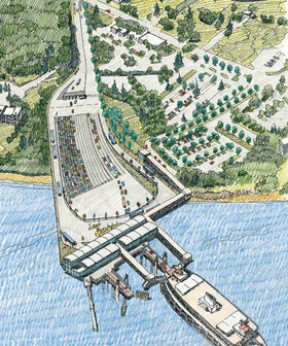Funding is in place, and public input is sought on design plans.
With a new design consultant on board, Washington State Ferries has set sail toward redevelopment of the Bainbridge Island ferry terminal.
KPFF consulting engineers was selected by WSF this week to update the terminal master plan, with a series of public meeetings to be held this spring. No dates have been announced.
Developed in 1998, the terminal redevelopment plan was delayed by funding shortfalls after the passage of Initiative 695, which cut the state motor-vehicle-excise tax, a key source of capital funding for WSF.
Over the seven years it’s taken to secure the $80 million required for the ambitious redevelopment, the WSF has seen the need to incorporate new goals, including Homeland Security protection measures.
“Many changes have taken place at WSF and in the community since the 1998 master plan was developed,†said WSF spokeswoman Joy Goldenberg. “WSF needs to work with the community to identify those changes and re-examine the conclusions and recommendations to the original plan.â€
Spanning eight years, the terminal redevelopment project will begin with trestle replacement and dock widening.
A new terminal building bordering the waterfront is set for completion after 2010 and will replace the existing 55-year-old structure.
“Key components of the terminal are reaching the end of their useful life, including the dock, parts of which are rotting, and the overhead loading, which is in poor repair,†Goldenberg said,
She added that facilities for pedestrians, bicyclists and disabled people are also inadequate.
The terminal served 2.2 million vehicles and 6.8 passengers in 2004. Ridership is expected to grow as high as 11.5 million by 2030.
Kordonowy said she intends to hold WSF to its promise of including local input in the terminal design update.
As a member of the interview panel that selected KPFF, the mayor was impressed with the firm’s track record of community involvement in design processes.
“Not suprisingly, this community wants be informed about that important facility,†she said. “My being on the team is recognition on the part of WSF that the community will be part of the process.â€
Founded in Seattle and previously known as Kelly, Pittelko, Fritz and Forssen, the 45-year-old firm has crafted designs for such landmarks as Safeco Field, the Seattle Art Museum and the Washington Mutual Building. KPFF also worked on the Anacortes ferry terminal and Bremerton’s transit center.
WSF terminal engineering director Russ East said KPFF’s proposal “clearly demonstrated their enthusiasm for the project, as well as their expertise in planning and controlling the project’s scope, schedule and budget.â€
WSF’s challenge now is to gain the public’s trust, Kordonowy said. Ferry officials and KPFF must convince islanders of their commitment to hold steady on promised improvements, she said.
Pedestrian advocates were particularly annoyed last year, when WSF hinted that homeland security concerns would prevent a new overhead walkway linking the terminal with the Waterfront Park trail.
“There was a lot of heartache about that because the community worked so hard on access to the terminal from the waterfront,†Kordonowy said. “There’s not as much willingness to trust (WSF) and some are not convinced it’s all about Homeland Security.
“Regardless of what conditions change, there are some desires of the community that can’t be set aside.â€


